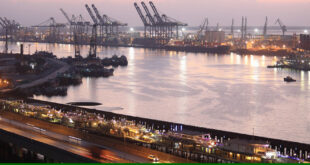In the global context, efficient logistics industry is a backbone of any economy and plays a strategic role in the overall economy of a country. Logistic industry eliminates wastages and makes the entire supply chain process efficient for the availability of the right product at the right time at economical cost.
Key players in the sector such as the port and airport operators, the cargo handling company, freight forwarders, customs brokers, internal transport enterprises, clearing agents, ship chandlers have to adopt best practices in order to develop a highly competitive logistics chain compared with the best in the world.
Logistics industry needs to be recognized as a proper industry to build around certain parameters and frame work to regulate this business. Lack of no regulatory mechanism has resulted in mushroom growth in the industry with no barrier to entry.
Attractive financing facilities should be available to the logistics sector, which can in turn play a key role in the overall economic cost and cheaper products to consumers.
Efficient trade
Pakistan’s trade logistics need urgent overhaul. The Pakistan-China Economic Corridor (CPEC) has created much optimism in improving the dwindling trade infrastructure of Pakistan. It envisages connecting Pakistan border to China via the port of Gwadar through road and railway linkage. The improvement in the infrastructure will enhance competitiveness within the logistics sector of Pakistan.
With the emergence of global supply chain, it has become important for countries to have efficient trade logistics to be able to effectively participate in the emerging global value chains.
There has been a realization in the policy circles and donor community in developing countries on the need to improve the logistics performance.
Railways is considered as the most efficient and cost effective mode for the transportation of goods. Around the world, the rail freight has seen tremendous development where rail haulage is being used not only to transport heavy and bulky goods but also consumer goods.
In United Kingdom, the railways transport as much as 75 percent of consumer goods from factories to distribution points. In Pakistan, the share is decreasing and more and more reliance is being done on road transport which is increasing congestion in the road network.
According to the study of the World Bank, a single freight train can replace one hundred trucks at a time from the road. The railways are also the most cost-effective mode of logistics where one gallon of fuel can transport one ton of goods to 250 miles compared to 90 miles by road.
Pakistan’s performance in the global logistics index has been below the global average which has impacted the competitiveness of its companies’ global trade and prevented its integration with global value chains.
The ‘Strategic Trade Policy Framework’ envisages Pakistan as a hub for trade and transit in the region. Logistics performance lies at the heart of trade competitiveness.
The policy makers will have to look beyond infrastructure to softer side of competitiveness that includes trade facilitation, improving service quality and sustainability of regulatory environment.
Pakistan Vision 2025 seeks to enhance the national transportation infrastructure by establishing an efficient and integrated transportation and logistics system.
Establishing industrial parks and developing SEZs along the China-Pakistan Economic Corridor (CPEC) will strengthen the transportation network and logistics infrastructure.
Road freight transportation contributed over 90 percent of the goods transported by land. Rail freight is likely to gain share due to modernization and expansion.
High priority is given to road network development. Private sector participation in logistics infrastructure development is likely to gain momentum, and transportation and warehousing are likely to lead logistics industry growth during 2016–2020.
The potential opportunities in the logistics industry in Pakistan, is estimated at approximately US$30.77 billion in 2015.
Key targets set in the national development initiatives for the transportation sector includes reduction in transportation costs, effective connectivity between rural areas and urban centers, inter-provincial high-speed connectivity.
Also high priority is given for the development of integrated road/rail networks between economic hubs (including air, sea and dry ports) and high capacity transportation corridors connecting with major regional trading partners.
Up-gradation of all major airports to trans-shipment hubs, development of cargo villages, modernization of rail transport, e-commerce, CPEC related investments in industrial centers and Special Economic Zones (SEZs) will serve as primary macro drivers for logistics sector growth.
CPEC related projects intend to upgrade and modernize road transport and related logistics infrastructure such as logistics park and establishment of cargo villages at major airports. High priority is given for road network development; private sector participation in logistics infrastructure development is likely to gain momentum.
Storage and warehousing demand from CPEC related industrial corridors are likely to derive increased storage and warehousing requirements including cold chain logistics, establishment of Cargo Villages Ports will facilitate goods traffic to central Asian countries and evolve as a major transshipment hub in the region.
Freight forwarding opportunities expected to increase due to increasing trade activities through Karachi and Port Qasim. Trade reforms expected to increase volume of trade with increase in inter and intra-regional trade.
Development of new port at Gwadar generates demand for warehousing, special economic zone, road and railway infrastructure network
Energy and transportation sectors are expected to see high growth due to increased investment relating to CPEC and National Transportation Plans between 2016 and 2020. This is expected to growth of transportation and warehousing segments between 2016 and 2020.
Pakistan advancing
Pakistan leaped seven spots in a closely watched logistics industry ranking of the world’s 45 leading emerging markets.
Pakistan advanced to No. 25 in the 2015 Agility Emerging Markets Logistics Index, an annual data-driven ranking accompanied by a separate survey of nearly 1,000 global logistics and supply chain executives. Colombia, which climbed four spots to No. 22, showed the next biggest gain in the Index.
The Index, now in its sixth year, ranks emerging markets based on their size, business conditions, infrastructure and other factors that make them attractive for investment by logistics companies, air cargo carriers, shipping lines, freight forwarders and distribution companies.
Large BRICS nations Brazil, Russia, India, China and South Africa have accounted for much of the growth and investment in emerging markets and have dominated the Index.
Saudi Arabia climbed to No. 2 in the 2015 Index, ranking behind only China, which has 47 times the population and 12.5 times the economic output.
India continues to divide logistics and supply chain executives. They ranked India as the No. 2 choice to emerge as a major logistics market and ranked it relatively high — No. 17 — among countries least likely to become a major logistics market.
In the data portion of the Index, India was leapfrogged in 2014 by Brazil and Saudi Arabia, and it slipped again in the 2015 Index, falling past Indonesia to No. 5.
There’s a retail boom taking place in Pakistan. This will bring many positives for the logistics industry. Big retail brands like Al-Karam, Gul Ahmed, Servis, etc have hundreds of outlets and are continuing to expand and nothing happens without logistics. Even if Amazon wants to sell something on the internet, it needs a very solid logistics backbone. Logistics industry is also going to witness a significant boom in the coming years.
 PAGE Blog Business Weekly Magazine
PAGE Blog Business Weekly Magazine

